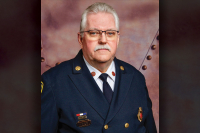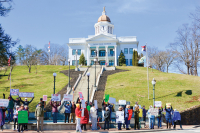Homeless shelter planned for Cherokee
 Work will begin on establishing a shelter for Cherokee’s homeless following passage of a resolution Principal Chief Patrick Lambert introduced this month.
Work will begin on establishing a shelter for Cherokee’s homeless following passage of a resolution Principal Chief Patrick Lambert introduced this month.
“This need, I think, has been apparent for a while,” Lambert told Tribal Council, asking for its support.
“The birth of this homeless shelter really started out in the first month of Chief Lambert taking office. We had folks every day who through no fault of their own find themselves in a situation where they’re out of luck,” said Sage Dunston, Lambert’s executive assistant.
Each month, Dunston said, Lambert’s office would field calls from 10 to 15 people who were dealing with a housing crisis. The tribe has an emergency housing program, but it’s often full with a waiting list — getting someone immediate assistance can be a challenge.
“It really pulls at your heartstrings to see mothers and children and fathers who come in and want what we all take for granted so often,” Dunston said.
The resolution, which Council adopted unanimously, doesn’t get into the specifics of the shelter’s budget and operations, simply authorizing Lambert to begin the process of establishing one. The facility would include an overnight shelter, a soup kitchen and life skills programming “to aid those in need of an opportunity to become more self-sufficient and capable of getting back on their feet,” the resolution reads.
Related Items
Councilmembers were vocal in their support of the concept.
“I like this resolution. It’s a great idea,” said Vice Chair Brandon Jones, of Snowbird.
“It’s a wonderful piece of legislation,” agreed Councilmember Tommye Saunooke, of Painttown, adding “Me and B (Councilmember Alan “B” Ensley, of Yellowhill) have been trying for years to get one, so now it’s there.”
Councilmember Teresa McCoy, of Big Cove, said she’s personally witnessed the need in her community, telling council about a call she received from a girl she’d once mentored. The girl asked for money, said she was hungry. McCoy said she met the girl with some food, but “before I could get out of the parking lot, people were shouting at me,” she said, wanting food as well.
“We are one of the richest tribes in the east, and there’s no sense in that,” she said.
But opening a homeless shelter isn’t going to fix all the problems overnight, cautioned tribal member Amy Walker.
“Where does that come from that causes them to opt out of life and just use drugs and to do those other things that causes a lot of our homelessness, the children not having food to eat, money being spent in a different way than it should be?” Walker asked. “I think if we address that issue, we could change this community that we wouldn’t have to keep spending money for a Band-Aid, giving them a place to stay overnight.”
Another portion of the discussion surrounded the question of who, exactly, the shelter would serve. Would it be open only to enrolled members of the Eastern Band of Cherokee Indians? Or to anyone who needed the services?
“My vision is that it’s for enrolled members,” Lambert said. “We have some of our own enrolled members that we found living under bridges.”
Councilmembers held differing opinions, but the vote they took this month didn’t include a decision on the matter.
“I hate to push those people away because the Bible also says ‘love thy neighbor,’” said Councilmember Adam Wachacha, of Snowbird.
“Eliminating non-enrolled members, that’s not the Cherokee way,” agreed Myrtle Driver, Cherokee translator for the Tribal Council. “The Cherokee way is you share, especially food.”
“Hungry people are hungry, regardless of whether they’re a tribal member, an alcoholic, a drug addict,” said McCoy. “I envision a place for people to come with no judgment.”
Those are valid points, said Chairman Bill Taylor, but Cherokee does have a responsibility to put its own people first.
“Sometimes we don’t know who comes onto our reservation, and we have this drug problem,” he said. “It sometimes can be a catch 22.”
But the important thing, Ensley said, it to get the ball rolling and continue having conversations about the specific ins and outs of how the still-hypothetical shelter should work.
“I think the regulations and everything that’s going to make this soup kitchen work, we’re all on the right page on this issue,” he said.
Going forward, Dunston said, Lambert and his staff will be working to plot the road toward opening day for the shelter, with a goal to have it done sometime this year.
“The chief has made it his priority,” Dunston said.
Specifics such as staffing, budget, revenue sources and location are yet to be determined. The tribe could renovate an existing building, or it could build something new. It could pay for the whole thing itself, or it could seek to supplement the cost with grants and partnerships from other sources. The shelter would be government-run, housed under the tribe’s Public Health and Human Services Division, but local churches have already expressed interest in playing a role.
“A number of churchgoers in the community have come up to me, and I’m sure others, and said they would like to volunteer and they would be interested in their church participating every now and then,” Dunson said. “I think that goes to show our tribe is still centered on family and still centered on helping our own.”









